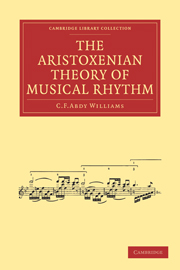Book contents
- Frontmatter
- PREFACE
- Contents
- MUSICAL ILLUSTRATIONS
- INTRODUCTION
- CHAPTER I
- CHAPTER II
- CHAPTER III
- CHAPTER IV
- CHAPTER V
- CHAPTER VI
- CHAPTER VII
- CHAPTER VIII
- CHAPTER IX
- CHAPTER X
- APPENDIX A Quotations, from original sources, of passages referred to in the text
- APPENDIX B Glossary of Technical Terms
- APPENDIX C Dactylo-epitritic, Logaœdic, and Dochmiac rhythms, and rhythmical modulation. M. Laloy's views
- INDEX
- Frontmatter
- PREFACE
- Contents
- MUSICAL ILLUSTRATIONS
- INTRODUCTION
- CHAPTER I
- CHAPTER II
- CHAPTER III
- CHAPTER IV
- CHAPTER V
- CHAPTER VI
- CHAPTER VII
- CHAPTER VIII
- CHAPTER IX
- CHAPTER X
- APPENDIX A Quotations, from original sources, of passages referred to in the text
- APPENDIX B Glossary of Technical Terms
- APPENDIX C Dactylo-epitritic, Logaœdic, and Dochmiac rhythms, and rhythmical modulation. M. Laloy's views
- INDEX
Summary
Aristoxenus says that not every possible division of a rhythmizomenon is rhythmical. Only when times are arranged in due proportion with one another is this the case. Certain combinations are condemned by our aesthetic feeling. There are fewer methods of grouping tones in melodious than in unmelodious succession, and this is also the case with regard to time-divisions. Hence a rhythmizomenon can be arranged rhythmically or unrhythmically, “errhythmically” or “arrhythmically.” And not only in these two ways: for the rhythmizomenon may be “eurhythmical,” i.e. “beautifully rhythmical.”
A phrase is errhythmical when its times are arranged in due proportion to one another, so that its rhythm becomes clear and convincing. Errhythm may, however, be inspiring or the reverse; it may express something, or nothing particular. A performance in which all the rhythmical details are brought out clearly and intelligently is errhythmical, but so also is the monotony of the mechanical perfection induced by a too frequent use of the metronome.
Similarly, any phrase that is correctly written as to its barring and accents, however monotonous it may be in effect, is errhythmical; but so also are the inspired phrases of a Mozart or a Beethoven.
Arrhythm arises if a phrase is barred or a composition phrased in such a way as to offend the aisthēsis, or to be incomprehensible.
- Type
- Chapter
- Information
- The Aristoxenian Theory of Musical Rhythm , pp. 34 - 48Publisher: Cambridge University PressPrint publication year: 2009First published in: 1911



